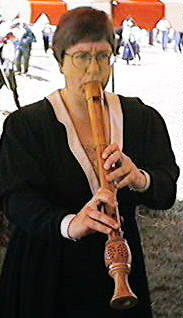 |
Appearance: What essentially defines a
recorder are that it has the following principals: the lip (cut near the top
of the body), the fipple (a block of wood inserted in the end to be blown),
and the windway (a narrow channel along the fipple through which air is
blown against the edge of the lip to produce sound). The body of the
instrument is straight and has any number of finger holes, and it typically
flares out at the end, although not always. Within those parameters, a
recorder can be almost anything. Some have strangely spaced finger
holes. Some are ornately decorated. They can be as small as the
width of a hand or longer than a human torso. There are really two
types of recorders: Baroque recorders and Renaissance recorders. The
main difference is that the Renaissance recorders have a larger bore, giving
them more strength in the lower series of notes. |



















